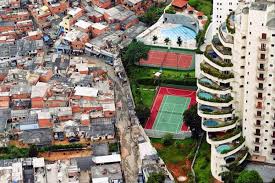A quick overview with our guest lecturer
By Danielle Perry 5/16/2017

An image portraying Sao Paulo economic disparities. A poor neighborhood on the left next to a rich neighborhood on the right.
Quality of care is a major concern for those using the Brazilian health care system Sistema Unico de Saude (SUS). Even though, the population data shows SUS has a positive impact on society, there is still a disproportionate amount of people choosing to supplement their public insurance with private. According to Naomar Filho, former president and current faculty advisor for Universidade Federal De Bahia “[ SUS Healthcare] System is unequal it’s not a matter of access it’s a matter of quality of care”. Therefore, his future research focuses on exposing factors contributing to differences in quality care. Over the course of two hours Dr. Filho expressed his desires to see social injustices eliminated therefore positively contributing to public health outcomes.
Our discussion began with a synopsis of the past work in social inequalities established and how they evolved into the healthcare system we see today. Although a lot of work has gone into the field there is yet more to uncover. The new Brazilian constitution of 1988 gave more economic freedom than in years past. It provided an opportunity to consider ways to reduce health disparities. A health disparity is a disproportionate difference in population health outcomes compared between groups. Current health disparities being addressed include 1) transportation 2) jobs 3) health and 4) education.
Indicators of said health outcomes are life expectancy and infant mortality rates. Life expectancy in Brazil increased from 54 years in 1960 to 74 years in 2014. From 1950 to 2015 there has been a substantial decrease in infant mortality rates from 141 per 1,00 live births to 18 per 1,000 live births. The decrease in mortality rates and the increase in life expectancy are due in part to health promotion programs and initiatives in Brazil.
One of Brazil’s more familiar health program is Bolsa Familia. Bolsa Familia is a cash transfer program . Families with income below a certain minimum wage BRL 77 are given R$77 to R$377 a month in exchange for completing some government requirements. In addition to the classes, every enrolled child in the program must have current vaccinations and enrolled in school. The Bolsa Familia program has contributed to reducing child mortality rates and poverty. It has also been attributed to increasing net health status and health promotion.
Social inequalities have shaped the culture of Brazil. Public and private health initiatives help eliminate health disparities every day. I am excited to see SUS work to change lives every day.
What an interesting post. How do you think this compares with the Affordable Care Act (Obamacare) and health disparities in the US? Do you think we have the same issues regarding quality of care?